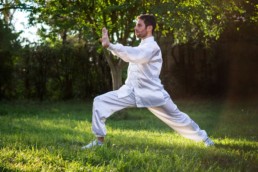
“Health is a relationship between you and your body.” — Terri Guillemets
In today’s fast-paced world, your health can quickly become less of a priority and, in turn, it becomes compromised.
Between work and home life, it can be challenging to find that optimal balance. This is where Qigong (pronounced chee-gun) comes into play.
This basic health system, based in Chinese medicine, can help you achieve a more physical lifestyle and meditative state.
Whether you’re looking to reduce pain or improve your mental health, here’s what this ancient practice can do for you.
What Exactly Is Qigong?
Qigong is a collective, umbrella term which includes a wide range of exercises, meditations, movements, reflections, and breathing — all of which were developed in China, more than 2,000 years ago.
While Eastern practitioners have understood the benefits associated with Qigong for centuries, this practice is only beginning to gain momentum in Western culture and research.
While Qigong is certainly a form of exercise, often used for martial arts training, it also requires you to master various mental skills. Think of it as a form of “moving meditation.” Through practice, you can benefit from improved sleep, greater inner peace and strength, improved energy, and greater vitality.
Currently, there are thousands of types of Qigong practice that have been developed across different regions of China. However, regardless of the style of Qigong you choose, each type shares key characteristics, including:
- Specific positions and movements that combine stationary and fluid exercises
- Movements that make you more aware of your breath and present state
- The importance of elevated focus and concentration
The National Qigong Association describes Qigong as a mind-body-spirit practice which targets your mental and physical health.
By incorporating movement, breathing techniques, posture, sound, self-massage, and focused intent, you can significantly improve numerous aspects of your everyday health — all of which is backed by scientific research.
In fact, one 2010 review, published in the American Journal of Health Promotion, reviewed a total of seventy-seven articles. Of all the studies examined, a total of 163 psychological and physiological health outcomes stemming from qigong were identified. From improved bone density to favorable cardiovascular effects, participants not only experienced improved health but also a greater quality of life.
What’s the difference between Tai Chi and Qigong?
Both Qigong and Tai Chi are ancient practices that aim to improve your mental and physical health — they also both cultivate Qi. In that sense, they share the same basic principles and fundamentals.
Just some of the main differences include:
- Tai Chi is said to be dense while Qigong is said to be light
- Tai Chi is more of a choreography, whereas Qigong is not
- In terms of meditation, Tai Chi is a less intense moving meditation, compared to the art of Qigong — which forces you to search deep within your realm of consciousness
Both of these practices offer immense benefits and although unique, they are not independent of one another.
If you are interested in a healthier, more enlightening life journey, it may be beneficial to learn and practice both Qigong and Tai Chi. This will allow you to maximize all aspects of these ancient practices.
How These Exercises Improve Your Well-being
The health benefits associated with Qigong are vast. This is based on the fact that Qigong implements restorative exercises that are gentle on your body.
As you begin to incorporate these mind-body exercises into your daily routine, you can strengthen your body and mind, improve circulation, restore optimal balance, and increase flexibility.
Based on Qigong’s ability to act as a medicinal movement practice, scientific interest continues to grow. From pain to fatigue, anxiety to poor immune function, Qigong offers a vast number of health-boosting effects.
It’s important to note that there are various “categories” associated with Qigong, including medical Qigong, meditation Qigong, and martial Qigong. Depending on your goals, you’ll want to focus on the category that’s right for you.
- Medical Qigong — Slow, relaxed, and gentle, this category encourages healing by transmitting Qi into your body
- Meditation Qigong — Carried out while sitting, standing, or lying down, this category focuses on the mind-body relationship
- Martial Qigong — Much more strenuous and dynamic, this category harnesses the value of power and strength
7 Qigong Exercises to Try Today
It’s clear that the benefits associated with Qigong are vast — but where do you begin?
If you’re interested in kick-starting your own Qigong pathway, here are some recommended exercises to help you along your journey, as you begin to cultivate healing energy.
Top tip: Before you perform any exercise, be sure to start with a warm-up routine.
Exercise #1: Gentle Sway
Begin by swaying your arms, swinging in a gentle motion. As you twist, do so from your waist, not your knees.
Not only will this reduce your risk of injury but this motion also massages your internal organs.
Simply move your arms front to back, as you bend your knees slightly, allowing your hips to sway. During this time, really focus on releasing mental stress. A sample gentle sway video can be found here.
Exercise #2: The Accordion
For this exercise, you are going to feel the Qi energy in your hands as you mimic the movement associated with playing the accordion.
To begin, close your eyes and concentrate on the palms of your hands. Breathe slowly as you bring your hands together. Your palms should touch and your fingers should be pointing in an upwards direction.
Slowly move your hands outwards and when they’re approximately one foot apart, bring them back together. You can then alter the direction in which you move your hands back and forth.
A sample qigong video can be found here.
Exercise #3: Pumping the Qi
This exercise is a bit more tricky, involving the connection between the Ren Mai and Du Mai.
Standing tall, you’ll need to bring your hands to the front, maintaining a straight head and spine. Raise your hands as you bend your elbows, inhaling as your hands come up, before exhaling as they go down.
Repeat this process 6-7 times.
As you become more comfortable, you can elevate this exercise, particularly in terms of your breathing patterns.
A pumping the Qi video can be found here.
Exercise #4: Hands Hold Head
Much more mental than physical, this exercise requires you to tap your teeth together thirty-six times.
Not only does this stimulate Qi in your gums, but this also clears and awakens the mind.
Next, simply fold your hands together, placing them on the back of your head. As you pull your hands forward, you’ll want to push your head and body backward.
Repeat this nine times.
Exercise #5: Roll Back
Performed in a diagonal position, this exercise requires you to use your waist.
Begin by shifting very little weight onto your right foot before slightly turning your waist to the right. Lift both of your arms, extending them outwards, palms facing one another.
Place weight onto your left leg, turning your waist to the left. At this point, curve your right arm as if it were holding a ball against your chest, before swaying your arms and palms across your body.
A sample Roll back Qigong video can be found here.
Exercise #6: Single Whip
The Single Whip is often deemed the signature movement of Tai Chi, involving a moving hand position. In fact, it is a key movement when aiming to improve posture.
To begin, put the majority of your weight onto your left leg, extending your arms outwards.
As you turn your waist, put weight on your right leg.
Allow your arm to follow the movement as you pivot on your heel — always move your hands across your body.
Sample video can be found here.
Exercise #7: Ball of Energy
For this exercise, you can sit or stand.
Begin by rubbing your hands — this will activate your hand qi.
Next, separate your hands in order to feel the energy on your palms.
As you intently focus, you may feel what some describe as a “buzzing” feeling. Now you can move your palms back and forth.
Lastly, move one of your hands closer to the center, as you feel increasing pressure.
Repeat this with both hands, creating a wave sensation with the energy that lies between your palms.
Sample video can be found here.
Regardless of the exercises you implement into your routine, aim for a comprehensive exercise program that actively improves your strength and balance. As you begin to notice your mobility improving, you can then add more challenges steps into your routine.
The key is focusing on an optimal mix of mind and body exercises, incorporating anaerobic, aerobic, and resistance training exercises.
Also, be sure to create a space that allows you to feel comfortable, focused, and free. When you have a dedicated space to practice mindfulness, your journey will become much easier and more rewarding.
What’s Next?
About the author

